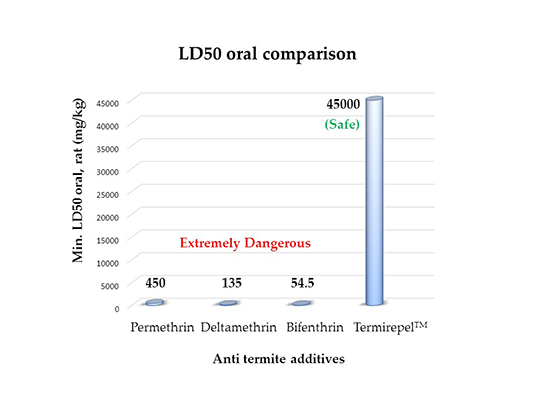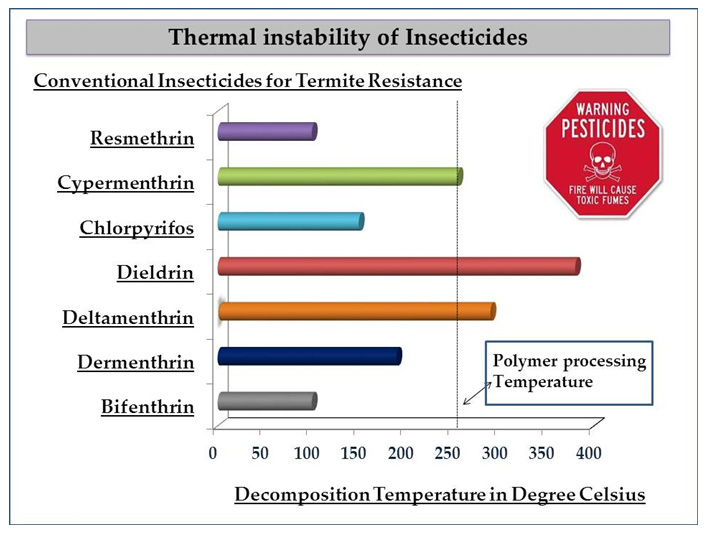When it comes to man-made structures such as buildings, termites have been estimated to cause approximately $32.5 billion in property damages every year. The termites have the ability to produce 10000 new
termites each year. This estimates out to be at least four termites each minute!
Basic Information
Termite barriers and wood preservatives
A termite barrier is a physical object that keeps termites from penetrating the foundation of a house or accessing other parts of the property. Termirepel™ can be incorporated in these
termite barriers and thus used for protection of the houses/structures from termites.
A solution of Termirepel™ liquid concentrate in the paint, in a predetermined ratio, can be mixed and be painted on the walls of the homes and structures to prevent insect damage. The
lacquer can be directly applied on the surface as a topical application. Sprays are easy to use products which can be sprayed to repel the insects.
Termirepel™ can also be used as a wood preservative to protect furniture and wooden articles from infestation from aggressive Formosan termites which are known to inhabit wooden
constructions.
Telecommunication:
Subterranean termites and other insects are known to feed on wires and cables which may be laid underground for transmission of information and communication purposes. This can expose wires and lead to
short circuits. The Termite Prevention and Control Research Institute have studies reporting that insects also damage wires and cables made from copper, iron, and aluminum. The insects secrete formic acid
which can dissolve the hardest of engineering plastics like Nylon 12. Hence the damage done to wires and cables needs to be addressed. Conventional insecticides cannot be used along with these wires and
cables as they aren’t meant for polymer processing temperatures often leading to toxic fumes which are a hazard to workers handling the processing of wires and cables. Termirepel
™ combines the need to deal with these pests as also of having extremely low toxic and low hazard additive for the telecommunication industry
Termirepel™ is available in the form of LDPE/EVA universal concentrates which can be easily incorporated in the cables during the process of extrusion. Termirepel™ works
by keeping the pests away from the target application & by conditioning the response of insects, without harming the pests in any way. Tests were conducted on actual cables in setting simulating
real-world conditions as they would exist in the environment. Termirepel™ has proven to be effective against a wide variety of insects and termites, ranging from ants, cockroaches, etc.
The products in the form of lacquer and liquid concentrate can be applied as a topical application to protect the surface from insect damage. Sprays can be used on electronic devices, wires, and cables to
protect them from insect damage.
Agriculture:
Insects are most often responsible for damaging crops as it eats leaves or burrows in stems, fruit, or roots. Losses to the tune of 10,000 hectares of paddy crops getting destroyed due to insects and
worms have been reported in areas like Bhubaneswar, Orissa. This requires that the problem of insects be addressed in an effective manner.
The spread of pests and pathogens that damage plant life could cost global agriculture $540 billion a year, according to a report published by the Royal Botanic Gardens (RBG) at Kew in London.
Drip irrigation & Pipelines (pre-harvest losses): Drip irrigation, also known micro-irrigation, is an irrigation method which saves water and fertilizer by allowing water to drip slowly to the roots of
plants, through a network of valves, pipes, tubing, and emitters. However, the whole purpose of conservation of water using such systems turns futile if these tubes get vulnerable to damage by
subterranean termites or other such insects which feed on polymeric applications. This requires that the tubings and pipelines used for this purpose be insect resistant.
Storage containers and bags (post-harvest losses): In one of the studies assessing storage food grain loss in India through pests, a special FAO loss prevention program concluded that the losses to food
grains attributed to pests alone accounts to around $200 billion of food grain loss each year.Most of these losses resulted from infestation by several species of insects and damage by numerous molds and
mycotoxins. Similar losses have been reported over the years in various countries. These losses need to be minimized/nullified.
Agriculture equipment like irrigation pipes, greenhouse films, mulches, grain bags, etc. which is incorporated with Termirepel™ can be used to tackle this menace thereby reducing losses
of the grain. Liquid concentrate and lacquer can be applied as a topical application on this equipment and already installed material to protect it from insect damage.
Gas Sectors:
Sensitive applications such as gas transfer are disrupted when termites and insects try to feed or damage the rubber gas tubing and pipelines carrying gas.These applications are especially sensitive since
they are used for hauling natural gas over long distances and thus can lead to a potential disaster in case of a gas leak. Hence insect/termite proofing of the gas pipeline needs to be done effectively.
Termirepel™ can be incorporated into the gas tubings to protect it against damage from insects. The product being inert does not affect the gas in any way.
Railway Carriages:
Passenger coaches often are infested with roaches and bed bugs and several other insects. This can cause great discomfort for passengers, especially in long-distance trains. Pantry cars are also
vulnerable to cockroaches and other insect infestations which can contaminate the food via droppings, wings, etc. besides creating an unhygienic atmosphere. These problems can be addressed by the use of
Termirepel™ by blending with paint and coating the same to the coaches. Lacquer can be applied on the galvanized surface to protect it from insect damage. Sprays can be used on difficult
to reach areas and thereby prevent insect damage.
Hotel Industry:
Bed bugs and other insects pose the biggest recurring pest threat in hotel accommodation.People believe that only the unhygienic and the dirty hotels get bedbugs but the truth is that all hotels get
bedbugs. Whether it would be the cheapest hotel or the five star one, all hotels get bed bugs from time to time. Therefore any hotel in the world can be infested with bed bugs.
The insects find food almost everywhere, in the kitchen areas, in the garbage and even on the leftover trays. This causes contamination of food items resulting in the transmission of various diseases.
Many famous hotels and restaurants around the globe have been shut down permanently due to severe roach infestations.
Termirepel™ can be an effective solution against insect menace in the hotel industry.
Shipping Industry:
Termites cause large damage to boats in boat harbors or wooden surfaces in the interiors of the boats. Termites have been found eating a 60ft motorboat in a Florida boatyard. Formosan termites especially
are known to be found in 80% of the Yellowriver's boats in China. Once infested, it is very hard to get rid of the termites.
Bed bugs and cockroaches are a major problem on cruise lines and cruise vessels. There are numerous cases reported of infestation in the mattresses and seats with patrons being severely inconvenienced.
Ships and other marine structures can be protected from termites and other insects by a paint based solution of our Termirepel™ applied as an outer coating. Our products added to the
material of the mattresses and berths can prevent infestation by bed bugs and protect passengers from harm.
Heritage construction preservation
Wooden sculptures and artifacts often get attacked by termites. Over the period it is observed that the wooden and brick structures are attacked by fungus and sticky insects disturbing the appearance of
these structures.Termirepel™ can be used as a wood preservative to protect sculptures and wooden articles from insect infestations.
OEMs (Original Equipment Manufacturing)
Many electronic companies have been trying to come up with new methods to prevent the cable and wiring of electronic devices from termite attacks. The subterranean termites are the oneswhich cause a huge
amount of damage in electrical sockets; as they fill the sockets with the mud for protecting themselves from their predators. Any accidental contact with such wet sockets can be proven to be a hazard in
the form of shock and short circuit.
Toxicity Overview – Non-Toxicity
Most often toxicologists use Lethal Dose and Lethal Concentration to gauge the toxicity of most chemicals; evaluated on many kinds of animals but most often testing is done with pests. The LD50 or LC50 is
one way to measure the short-term poisoning potential (acute toxicity) of a material.
LD50 Oral Comparison

LD50 Dermal Comparison

It is usually expressed as the amount of chemical administered (e.g., milligrams) per 100 grams (for smaller animals) or per kilogram (for bigger test subjects) of the body weight of the test animal. The
LD50 can be found for any route of entry or administration but dermal (applied to the skin) and oral (given by mouth) administration methods are the most common.
| Toxicity Classes:Gosselin, Smith and Hodge Scale |
| Probable Oral Lethal Dose (Human) |
| Toxicity Rating or Class |
Dose |
For 70-kg Person (150 lbs) |
|
| 6 Super Toxic |
Less than 5 mg/kg |
1 grain (a taste - less than 7 drops) |
| 5 Extremely Toxic |
5-50 mg/kg |
4 ml (between 7 drops and 1 tsp) |
| 4 Very Toxic |
50-500 mg/kg |
30 ml (between 1 tsp and 1 fl ounce) |
| 3 Moderately Toxic |
0.5-5 g/kg |
30-600 ml (between 1 floz and 1 pint) |
| 2 Slightly Toxic |
5-15 g/kg |
600-1200 ml (between 1 pint to 1 quart) |
| 1 Practically Non-Toxic |
Above 15 g/kg |
More than 1200 ml (more than 1 quart) |
Please see the scale on toxicity tabulated by Gosselin, Smith and Hodge.
Some of the widely used insecticides/Termicides include pyrethroids based insecticides. Pyrethroids include a wide range of compounds the most commonly used being Permethrin, Deltamethrin, Bifenthrin,
Cypermethrin, Resmethrin, and Sumithrin. Apart from these insecticides based on Chlorpyrifos and Dieldrin are also present in the market.
These insecticides also have a host of problems associated with them which can be summarized here:
| Main Ingredient |
Toxicity Class |
Toxicity Comments |
Thermal Stability |
| Permethrin |
Class II to Class III, US- EPA has classified it as RUP (Restricted Use Pesticide) |
Permethrin, like all synthetic pyrethroids, is a neurotoxin. Symptoms include tremors, incoordination, elevated body temperature, increased aggressive behavior, and disruption of learning.
Laboratory tests suggest that permethrin is more acutely toxic to children than to adults.
|
Boils at 200°C. Thus, most of the insecticide evaporates during processing itself, moreover giving toxic fumes. |
| Deltamethrin |
Class I to II, US- EPA classified as highly to moderately toxic |
Deltamethrin can induce skin sensations in exposed workers. There have been several non-fatal cases of poisoning following occupational exposure when safety precautions were not followed.
Vertigo and numbness, itching, tingling, and burning of the skin have been frequently reported
|
Mp- 98-101°C, Bp & decomposition- 300°C. Stable at polymer processing temperatures |
| Bifenthrin- erucamide |
Class II, US EPA classified as moderately toxic |
US EPA- Carcinogen, Very highly toxic to marine/ aquatic life. *chemicals that are one or more of the following: highly acutely toxic, a cholinesterase inhibitor, a known/probable
carcinogen, known groundwater pollutant or known reproductive or developmental toxicant.
|
Mp- 68-70.6°C, Flash Point- >100 C, Decomposes before boiling |
| Termirepel™ |
Class IV, US EPA, practically non- toxic, FIFRA exempted, ROHS compliant |
It is as non- toxic as an apple/ banana to humans. |
Stable up to highest polymer processing temperatures. |


